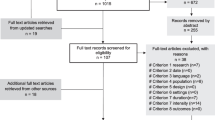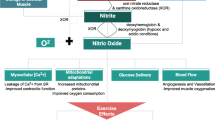Abstract
Background
Exercise-induced bronchoconstriction (EIB) describes the phenomenon of transient airway narrowing in association with physical activity. Although it may seem likely that EIB would have a detrimental impact on athletic performance, this has yet to be established.
Objectives
The aim of this review is to provide a systematic appraisal of the current status of knowledge regarding EIB and exercise performance and to highlight potential mechanisms by which performance may be compromised by EIB.
Data Sources and Study Selection
PubMed/Medline and EBSCO databases were searched up to May 2014 using the search parameter: [(‘exercise’ OR ‘athlete’) AND (‘asthma’ OR ‘bronchoconstriction’ OR ‘hypersensitivity’) AND ‘performance’]. This search string returned 243 citations. After systematically reviewing all of the abstracts, 101 duplicate papers were removed, with 132 papers excluded for not including an exercise performance outcome measure.
Results
The remaining ten studies that met the initial criteria were included in this review; six evaluated the performance of physically active individuals with asthma and/or EIB while four assessed the effects of medication on performance in a comparable population.
Conclusion
The evidence concludes that whilst it is reasonable to suspect that EIB does impact athletic performance, there is currently insufficient evidence to provide a definitive answer.



Similar content being viewed by others
References
IOC.http://www.olympic.org/olympic-results/london-2012/athletics. 2012. Accessed Jan 2014.
Bassett JRDR, Howley ET. Limiting factors for maximum oxygen uptake and determinants of endurance performance. Med Sci Sports Exerc. 2000;32(1):70–84.
Dempsey JA. JB Wolffe memorial lecture. Is the lung built for exercise? Med Sci Sports Exerc. 1986;18(2):143–55.
Price OJ, Ansley L, Menzies-Gow A, et al. Airway dysfunction in elite athletes—an occupational lung disease? Allergy. 2013;68(11):1343–52.
Weiler JM, Bonini S, Coifman R, et al. American Academy of Allergy, Asthma & Immunology Work Group report: exercise-induced asthma. J Allergy Clin Immunol. 2007;119(6):1349–58.
Haahtela T, Malmberg P, Moreira A. Mechanisms of asthma in Olympic athletes—practical implications. Allergy. 2008;63(6):685–94.
McKenzie DC, Fitch KD. The asthmatic athlete: inhaled beta-2 agonists, sport performance, and doping. Clin J Sport Med. 2011;21(1):46–50.
Fitch KD. An overview of asthma and airway hyper-responsiveness in Olympic athletes. Br J Sports Med. 2012;46(6):413–6.
Price OJ, Hull JH. Asthma in elite athletes: who cares? Clin Pulmonary Med. 2014;21(2):68–75.
Stickland MK, Rowe BH, Spooner CH, et al. Effect of warm-up exercise on exercise-induced bronchoconstriction. Med Sci Sports Exerc. 2012;44(3):383–91.
Teixeira RN, Teixeira LR, Costa LAR, et al. Exercise-induced bronchoconstriction in elite long-distance runners in Brazil. J Bras Pneumol. 2012;38(3):292–8.
Sonna LA, Angel KC, Sharp MA, et al. The prevalence of exercise-induced bronchospasm among US army recruits and its effects on physical performance. Chest. 2001;119(6):1676–84.
Freeman W, Nute M, Brooks S, et al. Responses of asthmatic and non-asthmatic athletes to prolonged treadmill running. Br J Sports Med. 1990;24(3):183–90.
Freeman W, Williams C, Nute M. Endurance running performance in athletes with asthma. J Sports Sci. 1990;8(2):103–17.
Stensrud T, Berntsen S, Carlsen K-H. Exercise capacity and exercise-induced bronchoconstriction (EIB) in a cold environment. Respir Med. 2007;101(7):1529–36.
Stensrud T, Berntsen S, Carlsen KH. Humidity influences exercise capacity in subjects with exercise-induced bronchoconstriction (EIB). Respir Med. 2006;100(9):1633–41.
Steinshamn S, Sandsund M, Sue-Chu M, et al. Effects of montelukast on physical performance and exercise economy in adult asthmatics with exercise-induced bronchoconstriction. Scand J Med Sci Sports. 2002;12(4):211–7.
Steinshamn S, Sandsund M, Sue-Chu M, et al. Effects of montelukast and salmeterol on physical performance and exercise economy in adult asthmatics with exercise-induced bronchoconstriction. Chest. 2004;126(4):1154–60.
Freeman W, Packe G, Cayton R. Effect of nebulised salbutamol on maximal exercise performance in men with mild asthma. Thorax. 1989;44(11):942–7.
Koch S, MacInnis MJ, Sporer BC, et al. Inhaled salbutamol does not affect athletic performance in asthmatic and non-asthmatic cyclists. Br J Sports Med. 2013. doi:10.1136/bjsports-2013-092706.
Guyatt GH, Oxman AD, Schünemann HJ, et al. GRADE guidelines: a new series of articles in the Journal of Clinical Epidemiology. J Clin Epidemiol. 2011;64(4):380–2.
McNicholl DM, Megarry J, McGarvey LP, et al. The utility of cardiopulmonary exercise testing in difficult asthma. Chest. 2011;139(5):1117–23.
Kukafka DS, Ciccolella D, D’Alonzo GE Jr, et al. Exercise-induced bronchospasm in high school athletes via a free running test. Chest. 1998;114(6):1613–22.
Medelli J, Lounana J, Messan F, et al. Testing of pulmonary function in a professional cycling team. J Sports Med Phys Fitness. 2006;46(2):298–306.
Patton JF, Vogel JA. Effects of acute cold exposure on submaximal endurance performance. Med Sci Sports Exerc. 1984;16(5):494–7.
Kippelen P, Bolger C, Malatesta D, et al. Does exercise-induced bronchoconstriction affect oxygen uptake kinetics in athletes? 15th Annual Congress of the European College of Sport Science; 2010; Antalya, Turkey; 2010.
Legaz-Arrese A, Munguía-Izquierdo D, NuvialaNuviala A, et al. Average VO2max as a function of running performances on different distances. Sci Sports. 2007;22(1):43–9.
Dickinson J, Hu J, Chester N, et al. The physiological effect of 800 mcg and 1600 mcg inhaled salbutamol during a football specific treadmill run at high ambient temperatures. Br J Sports Med. 2011;45(15):A19–20.
Hull J, Conlon J, Gateley B, et al. Does salbutamol improve athletic performance in elite soccer players with EIB? C22. Asthma therapy. American Thoracic Society; 2012. p. A3969-A.
Kalsen A, Hostrup M, Bangsbo J, et al. Combined inhalation of beta2-agonists improves swim ergometer sprint performance but not high-intensity swim performance. Scand J Med Sci Sports. 2013. doi:10.1111/sms.12096.
Crimi E, Pellegrino R, Smeraldi A, et al. Exercise-induced bronchodilation in natural and induced asthma: effects on ventilatory response and performance. J Appl Physiol. 2002;92(6):2353–60.
Haverkamp H, Dempsey J, Miller J, et al. Gas exchange during exercise in habitually active asthmatic subjects. J Appl Physiol. 2005;99(5):1938–50.
Kosmas E, Milic-Emili J, Polychronaki A, et al. Exercise-induced flow limitation, dynamic hyperinflation and exercise capacity in patients with bronchial asthma. Eur Respir J. 2004;24(3):378–84.
Calverley P. Exercise and dyspnoea in COPD. Eur Respir Rev. 2006;15(100):72–9.
Aaron E, Seow K, Johnson B, et al. Oxygen cost of exercise hyperpnea: implications for performance. J Appl Physiol. 1992;72(5):1818–25.
Vella CA, Marks D, Robergs RA. Oxygen cost of ventilation during incremental exercise to VO2max. Respirology. 2006;11(2):175–81.
Dempsey JA, Romer L, Rodman J, et al. Consequences of exercise-induced respiratory muscle work. Respir Physiol Neurobiol. 2006;151(2–3):242–50.
Harms CA, Wetter TJ, Croix CMS, et al. Effects of respiratory muscle work on exercise performance. J Appl Physiol. 2000;89(1):131–8.
Parshall MB, Schwartzstein RM, Adams L, et al. An official American Thoracic Society statement: update on the mechanisms, assessment, and management of dyspnea. Am J Respir Crit Care Med. 2012;185(4):435–52.
Noakes TD. Linear relationship between the perception of effort and the duration of constant load exercise that remains. J Appl Physiol. 2004;96(4):1571–3.
Caeauelli E, Nobel BJ. The effect of inspired carbon dioxide on subjective estimates of exertion during exercise. Ergonomics. 1976;19(5):581–9.
Widdicombe J. Lung afferent activity: implications for respiratory sensation. Respir Physiol Neurobiol. 2009;167(1):2–8.
Nishino T. Dyspnoea: underlying mechanisms and treatment. Br J Anaesth. 2011;106(4):463–74.
Moxham J, Jolley C. Breathlessness, fatigue and the respiratory muscles. Clin Med. 2009;9(5):448–52.
Goubault C, Perault M, Leleu E, et al. Effects of inhaled salbutamol in exercising non-asthmatic athletes. Thorax. 2001;56(9):675–9.
Dempsey JA, Wagner PD. Exercise-induced arterial hypoxemia. J Appl Physiol. 1999;87(6):1997–2006.
Muñoz PA, Gómez FP, Manrique HA, et al. Pulmonary gas exchange response to exercise-and mannitol-induced bronchoconstriction in mild asthma. J Appl Physiol. 2008;105(5):1477–85.
Parsons JP, Hallstrand TS, Mastronarde JG, et al. An official American Thoracic Society clinical practice guideline: exercise-induced bronchoconstriction. Am J Respir Crit Care Med. 2013;187(9):1016–27.
Bonini M, Di Mambro C, Calderon MA, et al. Beta-2 agonists for exercise induced asthma. Cochrane Libr. 2009. doi:10.1002/14651858.CD003564.pub3.
Bedi J, Gong H Jr, Horvath S. Enhancement of exercise performance with inhaled albuterol. Can J Sport Sci. 1988;13(2):144–8.
Kindermann W. Do inhaled beta(2)-agonists have an ergogenic potential in non-asthmatic competitive athletes? Sports Med. 2007;37(2):95–102.
Pluim BM, de Hon O, Staal JB, et al. β2-agonists and physical performance. Sports Med. 2011;41(1):39–57.
WADA. http://www.wada-ama.org/Documents/World_AntiDoping_Program/WADP-Prohibited-list/To_be_effective/WADA_Prohibited_List_2011_EN.pdf. Accessed April 2014.
Sporer BC, Sheel AW, McKenzie DC. Dose response of inhaled salbutamol on exercise performance and urine concentrations. Med Sci Sports Exerc. 2008;40(1):149–57.
Van Baak M, De Hon O, Hartgens F, et al. Inhaled salbutamol and endurance cycling performance in non-asthmatic athletes. Int J Sports Med. 2004;25(7):533–8.
Decorte N, Bachasson D, Guinot M, et al. Impact of salbutamol on neuromuscular function in endurance athletes. Med Sci Sports Exerc. 2013;45(10):1925–32.
Ingemann-Hansen T, Bundgaard A, Halkjær-Kristensen J, et al. Maximal oxygen consumption rate in patients with bronchial asthma-the effect of β2-adrenoreceptor stimulation. Scand J Clin Lab Invest. 1980;40(2):99–104.
Dickinson J, Molphy J, Chester N, et al. The ergogenic effect of long-term use of high dose salbutamol. Clin J Sport Med. 2014. doi:10.1097/JSM.0000000000000076.
Dickinson J, Hu J, Chester N, et al. Acute impact of inhaled short acting β2-agonists on 5 km running performance. J Sports Sci Med. 2014;13(2):271–9.
Caruso JF, Hamill JL, De Garmo N. Oral albuterol dosing during the latter stages of a resistance exercise program. J Strength Cond Res. 2005;19(1):102–7.
Elers J, Pedersen L, Henninge J, et al. The pharmacokinetic profile of inhaled and oral salbutamol in elite athletes with asthma and nonasthmatic subjects. Clin J Sport Med. 2012;22(2):140–5.
Hull J, Ansley L, Garrod R, et al. Exercise-induced bronchoconstriction in athletes-should we screen? Med Sci Sports Exerc. 2007;39(12):2117–24.
Acknowledgments
No sources of funding were used to assist in the preparation of this review. The authors have no real or perceived conflict of interest in respect of the content of this review. The manuscript does not contain clinical studies of patient data. All authors contributed to the preparation of this manuscript.
Author information
Authors and Affiliations
Corresponding author
Rights and permissions
About this article
Cite this article
Price, O.J., Hull, J.H., Backer, V. et al. The Impact of Exercise-Induced Bronchoconstriction on Athletic Performance: A Systematic Review. Sports Med 44, 1749–1761 (2014). https://doi.org/10.1007/s40279-014-0238-y
Published:
Issue Date:
DOI: https://doi.org/10.1007/s40279-014-0238-y




